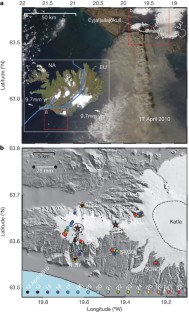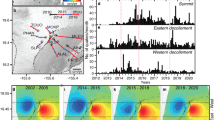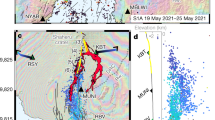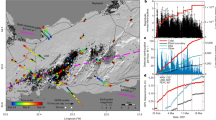Abstract
Gradual inflation of magma chambers often precedes eruptions at highly active volcanoes. During such eruptions, rapid deflation occurs as magma flows out and pressure is reduced1,2,3. Less is known about the deformation style at moderately active volcanoes, such as Eyjafjallajökull, Iceland, where an explosive summit eruption of trachyandesite beginning on 14 April 2010 caused exceptional disruption to air traffic, closing airspace over much of Europe for days. This eruption was preceded by an effusive flank eruption of basalt from 20 March to 12 April 2010. The 2010 eruptions are the culmination of 18 years of intermittent volcanic unrest4,5,6,7,8,9. Here we show that deformation associated with the eruptions was unusual because it did not relate to pressure changes within a single magma chamber. Deformation was rapid before the first eruption (>5 mm per day after 4 March), but negligible during it. Lack of distinct co-eruptive deflation indicates that the net volume of magma drained from shallow depth during this eruption was small; rather, magma flowed from considerable depth. Before the eruption, a ∼0.05 km3 magmatic intrusion grew over a period of three months, in a temporally and spatially complex manner, as revealed by GPS (Global Positioning System) geodetic measurements and interferometric analysis of satellite radar images. The second eruption occurred within the ice-capped caldera of the volcano, with explosivity amplified by magma–ice interaction. Gradual contraction of a source, distinct from the pre-eruptive inflation sources, is evident from geodetic data. Eyjafjallajökull’s behaviour can be attributed to its off-rift setting with a ‘cold’ subsurface structure and limited magma at shallow depth, as may be typical for moderately active volcanoes. Clear signs of volcanic unrest signals over years to weeks may indicate reawakening of such volcanoes, whereas immediate short-term eruption precursors may be subtle and difficult to detect.
This is a preview of subscription content, access via your institution
Access options
Subscribe to this journal
Receive 51 print issues and online access
$199.00 per year
only $3.90 per issue
Buy this article
- Purchase on Springer Link
- Instant access to full article PDF
Prices may be subject to local taxes which are calculated during checkout



Similar content being viewed by others
References
Dzurisin, D. Volcano Deformation (Springer, 2007)
Amelung, F., Jónsson, S., Zebker, H. & Segall, P. Widespread uplift and trapdoor faulting on Galápagos volcanoes observed with radar interferometry. Nature 407, 993–996 (2000)
Sigmundsson, F. Iceland Geodynamics: Crustal Deformation and Divergent Plate Tectonics (Springer, 2006)
Pedersen, R. & Sigmundsson, F. InSAR based sill model links spatially offset areas of deformation and seismicity for the 1994 unrest episode at Eyjafjallajökull volcano, Iceland. Geophys. Res. Lett. 31 L14610 10.1029/2004GL020368 (2004)
Pedersen, R. & Sigmundsson, F. Temporal development of the 1999 intrusive episode in the Eyjafjallajökull volcano, Iceland, derived from InSAR images. Bull. Volcanol. 68, 377–393 (2006)
Hooper, A., Pedersen, R. & Sigmundsson, F. in The VOLUME Project — Volcanoes: Understanding Subsurface Mass Movement (eds Bean, C. J. et al.) 13–24 (University College Dublin, 2009)
Sturkell, E., Sigmundsson, F. & Einarsson, P. Recent unrest and magma movements at Eyjafjallajokull and Katla Volcanoes, Iceland. J. Geophys. Res. 108 2369 10.1029/2001JB000917 (2003)
Sturkell, E. et al. Katla and Eyjafjallajökull Volcanoes. Dev. Quat. Sci. 13, 5–21 (2010)
Hooper, A. A multi-temporal InSAR method incorporating both persistent scatterer and small baseline approaches. Geophys. Res. Lett. 35 L16302 10.1029/2008GL034654 (2008)
Oskarsson, N., Sigvaldason, G. E. & Steinthórsson, S. A dynamic model of rift zone petrogenesis and the regional petrology of Iceland. J. Petrol. 23, 28–74 (1985)
Larsen, G., Dugmore, A. J. & Newton, A. J. Geochemistry of historical-age silicic tephras in Iceland. Holocene 9, 463–471 (1999)
Hjaltadottir, S. & Vogfjord, K. Seismic evidence of magma transport in Eyjafjallajökull during 2009–2010. Eos 91(Fall meet. suppl) (abstract V21F-02)
Gudmundsson, M. T. et al. The Eyjafjallajökull eruption in April-May 2010; course of events, ash generation and ash dispersal. Eos 91(Fall meet. suppl.) (abstract V53F-01)
Eineder, M. & Fritz, T. TerraSAR-X Ground Segment Basic Product Specification Document TX-GS-DD-3302 (DLR, 2009)
Okada, Y. Internal deformation due to shear and tensile faults in a half-space. Bull. Seismol. Soc. Am. 82, 1018–1040 (1992)
Fialko, Y., Khazan, Y. & Simons, M. Deformation due to a pressurized horizontal circular crack in an elastic half-space, with applications to volcano geodesy. Geophys. J. Int. 146, 181–190 (2001)
Hooper, A., Segall, P. & Zebker, H. Persistent scatterer interferometric synthetic aperture radar for crustal deformation analysis, with application to Volcan Alcedo, Galapagos. J. Geophys. Res. 112 B07407 10.1029/2006JB004763 (2007)
Hjaltadóttir, S., Vogfjörð, K. S. & Slunga, R. Seismic Signs of Magma Pathways Through the Crust in the Eyjafjallajökull Volcano, South Iceland. (Icelandic Meteorological Office report VÍ 2009-13, 2009)
Vogfjörd, K. S., Hjaltadóttir, S., Kjartansson, E. & Roberts, M. J. in The VOLUME Project — Volcanoes: Understanding Subsurface Mass Movement (eds Bean, C. J. et al.) 237–249 (University College Dublin, 2009)
Taisne, B. & Jaupart, C. Dike propagation through layered rocks. J. Geophys. Res. 114 B09203 10.1029/2008JB006228 (2009)
Sigmarsson O, Vlastelic, I. & Devidal, J. Trace-element variations reveal dynamic magma mixing during the 2010 eruption of Eyjafjallajökull, Iceland. Eos 91(Fall meet. suppl.) (abstract V21F-04)
Eichelberger, J. C., Izbekov, P. E. & Browne, B. L. Bulk chemical trends at arc volcanoes are not liquid lines of descent. Lithos 87, 135–154 (2006)
Marsh, B. A magmatic mush column Rosetta Stone: The McMurdo Dry Valleys of Antarctica. Eos 47, 497–508 (2004)
Hreinsdóttir, S. & Bennett, R. A. Active aseismic creep on the Alto Tiberina low-angle normal fault, Italy. Geology 37, 683–686 (2009)
Kampes, B., Hanssen, R. F. & Zbigniew, P. Radar interferometry with public domain tools. In Proceedings ‘Fringe 2003 Workshop’ (ESA SP-550, European Space Agency, 2004)
Jakobsdóttir, S. S. Seismicity in Iceland: 1994–2007. Jökull 58, 75–100 (2008)
Hooper, A. et al. Is magma generated due to retreating ice caps, likely to erupt? Constraints on lower-crustal stress in Iceland from InSAR. In Proceedings ‘Fringe 2009 Workshop’ (ESA SP-677, European Space Agency, 2010)
Yun, S., Segall, P. & Zebker, H. Constraints on magma chamber geometry at Sierra Negra volcano, Galapagos Islands, based on InSAR observations. J. Volcanol. Geotherm. Res. 150, 232–243 (2006)
Feigl, K. L. & Thurber, C. H. A method for modelling radar interferograms without phase unwrapping: application to the M 5 Fawnskin, California earthquake of 1992 December 4. Geophys. J. Int. 176, 491–504 (2009)
Árnadóttir, T., Jiang, W., Feigl, K. L., Geirsson, H. & Sturkell, E. Kinematic models of plate boundary deformation in southwest Iceland derived from GPS observations. J. Geophys. Res. 111 B07402 10.1029/2005JB003907 (2006)
Bödvarsson, R., Rögnvaldsson, S., Th, Slunga, R. & Stefánsson, R. The SIL data acquisition and monitoring system. Seismol. Res. Lett. 67, 35–46 (1996)
Jakobsdóttir, S. S., Guðmundsson, G. B. & Sefánsson, R. Seismicity in Iceland 1991-2000 monitored by the SIL seismic system. Jökull 51, 87–94 (2002)
Hooper, A. A statistical-cost approach to unwrapping the phase of InSAR time series. In Proceedings ‘Fringe 2009 Workshop’ (ESA SP-677, European Space Agency, 2010)
Jónsson, S., Zebker, H., Segall, P. & Amelung, F. Fault slip distribution of the Mw 7.2 Hector Mine earthquake estimated from satellite radar and GPS measurements. Bull. Seismol. Soc. Am. 92, 1377–1389 (2002)
King, R. W. & Bock, Y. GAMIT Reference Manual, GPS Analysis at MIT, Release 10.3 (Technical report, MIT, 2006)
Altamimi, Z., Collilieux, X., Legrand, J., Garayt, B. & Boucher, C. ITRF2005: A new release of the International Terrestrial Reference Frame based on time series of station positions and earth orientation parameters. J. Geophys. Res. 112 B09401 10.1029/2007JB004949 (2007)
Hreinsdóttir, S. et al. A complex earthquake sequence captured by the continuous GPS network in SW Iceland. Geophys. Res. Lett. 36 L12309 10.1029/2009GL038391 (2009)
Herring, T. A., King, R. W. & McClusky, S. C. GLOBK Reference Manual, Global Kalman Filter VLBI and GPS Analysis Program, Release 10.3 (Technical report, MIT, 2006)
Herring, T. MATLAB Tools for viewing GPS velocities and time series. GPS Solut. 7, 194–199 (2003)
Loughlin, S. C. The Evolution of the Eyjafjöll Volcanic System, Southern Iceland. Ph.D. thesis, Univ. Durham. (1996)
Jakobsson, S. P. Petrology of Recent basalts of the Eastern Volcanic Zone, Iceland. Acta Naturalia Islandica 26, 1–103 (1979)
Acknowledgements
We acknowledge the efforts of Th. Jónsson, J. Hólmjárn, S. Steinthórsson, H. Ólafsson, Th. Ingvarsson and B. Brandsdóttir in making field operations run smoothly, as well as consultation and discussions with the staff of our institutes. We thank P. Segall and C. Wicks for comments on the manuscript, and NASA/GSFC for use of the MODIS image. Financial support for this work was received from the Icelandic Research Fund, the research fund at the University of Iceland, and the US National Science Foundation (grant EAR 1042103). Funds were received for hazard mitigation from the Icelandic government. We thank the Geodesy Laboratory at the University of Arizona for computing facilities and UNAVCO for technical support. GMT public domain software was used for some figures. TerraSAR-X data were provided by the German Space Agency under project number GEO0609.
Author information
Authors and Affiliations
Contributions
F.S. coordinated the writing of the paper and the research it is based on; S.H. and F.S. supervised the installation of new semi-continuous GPS stations; A.H. formed the interferograms and modelled the joint geodetic dataset; S.H. analysed the GPS data and produced the GPS time series; T.Á. modelled the GPS displacements; A.H., F.S., K.L.F. and R.P. planned the InSAR data acquisitions; S.H., M.J.R., A.A., H.G., M.H., B.G.Ó., H.S., E.S., P.E. and F.S. did the GPS measurements; N.Ó. conducted the geochemical analysis; P.E. has been involved in monitoring the volcano since 1971; M.J.R., S.H., R.P., P.E., N.Ó and F.S. were involved in daily monitoring of the eruptive activity; J.D. unwrapped the interferograms; K.L.F. formed additional interferograms and modelled them; A.H., R.P., S.H. and J.D. produced the figures; F.S., A.H., S.H., T.Á., R.P., N.Ó, P.E. and K.L.F. led the writing of the paper, with all authors commenting on and discussing its results.
Corresponding author
Ethics declarations
Competing interests
The authors declare no competing financial interests.
Supplementary information
Supplementary Information
The file contains Supplementary Tables 1-2 and Supplementary Figures 1-5 with legends. (PDF 15026 kb)
Rights and permissions
About this article
Cite this article
Sigmundsson, F., Hreinsdóttir, S., Hooper, A. et al. Intrusion triggering of the 2010 Eyjafjallajökull explosive eruption. Nature 468, 426–430 (2010). https://doi.org/10.1038/nature09558
Received:
Accepted:
Published:
Issue Date:
DOI: https://doi.org/10.1038/nature09558
This article is cited by
-
Complex paths of magma propagation at Fernandina (Galápagos): The coexistence of circumferential and radial dike intrusion during the January 2020 eruption
Bulletin of Volcanology (2023)
-
Insights into volcanic hazards and plume chemistry from multi-parameter observations: the eruptions of Fimmvörðuháls and Eyjafjallajökull (2010) and Holuhraun (2014–2015)
Natural Hazards (2023)
-
Deformation and seismicity decline before the 2021 Fagradalsfjall eruption
Nature (2022)
-
Developments in the study of volcanic and igneous plumbing systems: outstanding problems and new opportunities
Bulletin of Volcanology (2022)
-
Baseline monitoring of volcanic regions with little recent activity: application of Sentinel-1 InSAR to Turkish volcanoes
Journal of Applied Volcanology (2021)
Comments
By submitting a comment you agree to abide by our Terms and Community Guidelines. If you find something abusive or that does not comply with our terms or guidelines please flag it as inappropriate.



